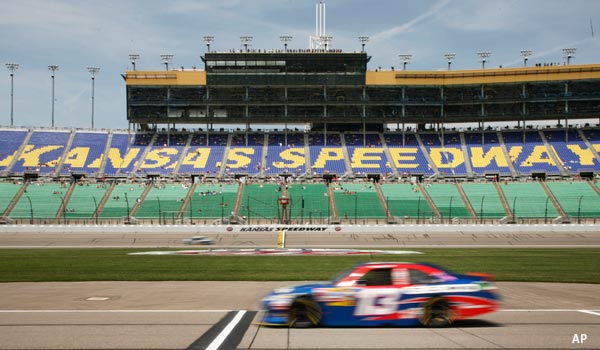KANSAS CITY, Kan. -- Auto Club Speedway in Fontana, Calif., received its second Sprint Cup Series race date in 2004 ? eight years after opening. In Auto Club's first seven years of existence,�sizable crowds were the norm, so a second date was totally feasible, right?
Fast forward to 2011. As we all know, Auto Club saw attendance fall after that second race was introduced, so much so that it's back to hosting one race a season.
Taking the date, unofficially, is Kansas Speedway, a track that's drawn well for the first 10 years of its life with one Sprint Cup race each season, run annually during the Chase. �Sunday's STP 400 marks the inaugural running of a "second" Cup race.
Because the tracks are similar ? both are intermediate tri-ovals and owned by International Speedway Corporation ? it's worth asking the question: Will Kansas also see attendance dwindle with the addition of a second Cup date?
Here's what Kansas Speedway president Pat Warren had to say when asked that exact question: "What I can tell you is we've got a strong track record, no pun intended, of selling lots of tickets for not only the Sprint Cup, but Nationwide, the Truck Series and even the IndyCar Series for the 10 years they ran here even in times when the sport was not as healthy everywhere else.
"That's sort of the first thing I point to is that we've had a full grandstands ? we haven't had sellouts, we've been very very close the last two years ? when other people have had lots and lots of empy seats. And I'm not talking about any particular track; I'm talking generally."
While Kansas City may be a much smaller market than the greater Los Angeles area, it doesn't have the competition that Auto Club Speedway�has in nearby�Las Vegas Motor Speedway (224 miles from Auto Club) and Phoenix International Raceway (311 miles). You have to drive almost 500 miles from Kansas Speedway to get to the next two closest Cup tracks in Chicagoland and Texas Motor Speedway.
"We draw from a good distance," Warren said. "We do very well going north. We sort of split with Texas going south. You get down to about Oklahoma City and that's sort of where it starts to thin out a bit. And that makes sense; travel time and other things and Texas has been open a little longer than we have."
Kansas's second Cup date hinged upon the state's approval of construction of a casino just outside Turn 2. The casino is currently under construction and scheduled to open next year. Livestrong Sporting Park, the home of the MLS team Sporting Kansas City, is just a block away from Turn 3 and opens June 9th. A minor league baseball stadium and retail giants are just a few blocks away.
Fifteen�years ago, the land just south of I-70, where the track is located some 20 minutes from downtown Kansas City, Mo.,�was, well, empty. Today, it's a booming shopping and entertainment district.
Auto Club Speedway,�about an hour drive�from downtown Los Angeles,�also grew a reputation for, ahem, unexciting racing. While at first glance Kansas has some of the same characteristics as Auto Club, it's produced some racing like Carl Edwards' banzai attempted pass of Jimmie Johnson in 2008, Ron Hornaday and Johnny Sauter's duel in 2010 and an IndyCar race with a three-wide finish and a .005 margin of victory in 2004.
What's helped produce that racing? Kansas's pavement.
The track surface is as old as the track, and while 11 years may not seem like much, Kansas City weather changes often. Frequent weather changes wreak havoc with asphalt, thus the distinctive tar seams all around the track.
However, the threat of repaving looms, eliminating the need for the seams, which Kurt Busch once called the "tar of death."
"The reality is that we're 11 years old and probably in the worst NASCAR market for freeze-thaw damage," Warren said, explaining�that tar seams are necessary to keep water from weeping onto the track. "In Kansas City in the winter, it can be 20 degrees or 10 degrees one day and 60 degrees the next, so that water freezes and thaws."
Now that Kansas has a race in June and October and with the climate, the window to repave isn't very big. And any potential resurfacing could impact the quality of racing.
"It's the nature of the beast," Warren said. "We're looking at those things and we're looking at the schedule. It could be something you see in the next few years."
Over the next few years, a lot of eyes will be on Kansas Speedway�to see which way the track goes. Will it continue to�boom like Texas Motor Speeway�has since recieving its second date or will it�bust like Auto Club?
Only time will tell.
Selita Ebanks Michael Michele Marisa Tomei Shannyn Sossamon Rachael Leigh Cook

No comments:
Post a Comment